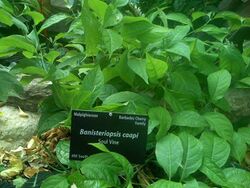Banisteriopsis caapi: Difference between revisions
>Josikins Redirected page to Harmala alkaloid#Banisteriopsis caapi |
>Graham m wiki ref formatting |
||
| (25 intermediate revisions by 5 users not shown) | |||
| Line 1: | Line 1: | ||
{{for|the [[DMT]]/[[MAOI]] plant brew that shares the same name as this plant|ayahuasca}} | |||
{{BotanyBox/Banisteriopsis caapi}} | |||
'''''Banisteriopsis caapi''''', also known as '''ayahuasca''', '''caapi''' or '''yagé''', is a South American liana of the family Malpighiaceae. It is used to prepare [[ayahuasca]], a decoction with a long history of its [[entheogen]]ic use and its status as a "plant teacher" among the indigenous peoples of the Amazon rainforest. | |||
==History and culture== | |||
===Research=== | |||
====Neurogenesis==== | |||
The alkaloids of ''Banisteriopsis caapi'', the plant source of the Amazonian hallucinogen [[ayahuasca]], stimulate adult neurogenesis ''in vitro''.<ref>{{cite journal | vauthors=((Morales-García, J. A.)), ((Fuente Revenga, M. de la)), ((Alonso-Gil, S.)), ((Rodríguez-Franco, M. I.)), ((Feilding, A.)), ((Perez-Castillo, A.)), ((Riba, J.)) | journal=Scientific Reports | title=The alkaloids of Banisteriopsis caapi, the plant source of the Amazonian hallucinogen Ayahuasca, stimulate adult neurogenesis in vitro | volume=7 | issue=1 | pages=5309 | date=13 July 2017 | url=https://www.nature.com/articles/s41598-017-05407-9 | issn=2045-2322 | doi=10.1038/s41598-017-05407-9}}</ref> | |||
==Chemistry== | |||
Banisteriopsis caapi (also known as ayahuasca, caapi or yajé) is a South American jungle vine of the family Malpighiaceae. It contains harmine, harmaline, and tetrahydroharmine in the following proportions: | |||
*'''Harmine:''' 0.31-8.43% | |||
*'''Harmaline:''' 0.03-0.83% | |||
* '''Proanthocyanidins''' (less known MAOIs) | |||
** '''(−)-epicatechin''' | |||
** '''(−)-procyanidins''' | |||
*'''Tetrahydroharmine:''' 0.05-2.94% | |||
==Toxicity and harm potential== | |||
===Dangerous interactions=== | |||
====Cholinergics==== | |||
[[Cholinergic]] substances combined with ''Banisteriopsis caapi'' can cause a [https://en.wikipedia.org/wiki/Cholinergic_crisis cholinergic crisis] because the plant contains acetylcholinesterase inhibitors (AChEIs): | |||
* Harmaline<ref name="Pubmed-19784581">{{cite journal | vauthors=((Zheng, X.)), ((Zhang, Z.)), ((Chou, G.)), ((Wu, T.)), ((Cheng, X.)), ((Wang, C.)), ((Wang, Z.)) | journal=Archives of Pharmacal Research | title=Acetylcholinesterase inhibitive activity-guided isolation of two new alkaloids from seeds of Peganum nigellastrum Bunge by an in vitro TLC- bioautographic assay | volume=32 | issue=9 | pages=1245–1251 | date= September 2009 | issn=0253-6269 | doi=10.1007/s12272-009-1910-x}}</ref> | |||
* Harmine<ref name="Pubmed-19784581" /> | |||
==See also== | |||
*''[[Peganum harmala]]'' | |||
*[[Beta-Carbolines]] | |||
*[[Psychedelics]] | |||
*[[Tryptamines]] | |||
*[[Phenethylamines]] | |||
==External links== | |||
** [https://en.wikipedia.org/wiki/Banisteriopsis_caapi ''Banisteriopsis caapi'' (Wikipedia)] | |||
** [https://erowid.org/plants/banisteriopsis/banisteriopsis.shtml ''Banisteriopsis caapi'' (Erowid Vault)] | |||
* Harmala alkaloids | |||
** [http://en.wikipedia.org/wiki/Harmala_alkaloid Harmala alkaloids (Wikipedia)] | |||
*** [https://en.wikipedia.org/wiki/Harmaline Harmaline (Wikipedia)] | |||
*** [https://en.wikipedia.org/wiki/Harmine Harmine (Wikipedia)] | |||
*** [https://en.wikipedia.org/wiki/Tetrahydroharmine Tetrahydroharmine (Wikipedia)] | |||
** [https://erowid.org/chemicals/harmala/harmala.shtml Harmala Alkaloids (Erowid Vault)] | |||
** [https://isomerdesign.com/PiHKAL/read.php?domain=tk&id=13 Harmaline (TiHKAL / Isomer Design)] | |||
** [https://isomerdesign.com/PiHKAL/read.php?domain=tk&id=14 Harmine (TiHKAL / Isomer Design)] | |||
** [https://isomerdesign.com/PiHKAL/read.php?domain=tk&id=54 Tetrahydroharmine (TiHKAL / Isomer Design)] | |||
==Literature== | |||
* Morales-García, J. A., de la Fuente Revenga, M., Alonso-Gil, S., Rodríguez-Franco, M. I., Feilding, A., Perez-Castillo, A., & Riba, J. (2017). The alkaloids of Banisteriopsis caapi, the plant source of the Amazonian hallucinogen Ayahuasca, stimulate adult neurogenesis in vitro. Scientific Reports, 7(1), 5309. https://doi.org/10.1038/s41598-017-05407-9 | |||
==References== | |||
<references/> | |||
[[Category:Acetylcholinesterase inhibitor]] | |||
[[Category:beta-Carboline]] | |||
[[Category:Entheogen]] | |||
[[Category:MAOI]] | |||
[[Category:Psychoactive substance]] | |||
Latest revision as of 17:44, 21 July 2022
| Banisteriopsis caapi | |
|---|---|
 |
|
| Taxonomical nomenclature | |
| Kingdom | Plantae |
| Unranked | Angiosperms |
| Unranked | Eudicots |
| Unranked | Rosids |
| Order | Malpighiales |
| Family | Malpighiaceae |
| Genus | Banisteriopsis |
| Species | B. caapi |
| Common nomenclature | |
| Common names | Ayahuasca, Caapi or Yagé |
| Constituents | |
| Active constituents | Harmala alkaloid |
Banisteriopsis caapi, also known as ayahuasca, caapi or yagé, is a South American liana of the family Malpighiaceae. It is used to prepare ayahuasca, a decoction with a long history of its entheogenic use and its status as a "plant teacher" among the indigenous peoples of the Amazon rainforest.
History and culture
Research
Neurogenesis
The alkaloids of Banisteriopsis caapi, the plant source of the Amazonian hallucinogen ayahuasca, stimulate adult neurogenesis in vitro.[1]
Chemistry
Banisteriopsis caapi (also known as ayahuasca, caapi or yajé) is a South American jungle vine of the family Malpighiaceae. It contains harmine, harmaline, and tetrahydroharmine in the following proportions:
- Harmine: 0.31-8.43%
- Harmaline: 0.03-0.83%
- Proanthocyanidins (less known MAOIs)
- (−)-epicatechin
- (−)-procyanidins
- Tetrahydroharmine: 0.05-2.94%
Toxicity and harm potential
Dangerous interactions
Cholinergics
Cholinergic substances combined with Banisteriopsis caapi can cause a cholinergic crisis because the plant contains acetylcholinesterase inhibitors (AChEIs):
See also
External links
- Harmala alkaloids
Literature
- Morales-García, J. A., de la Fuente Revenga, M., Alonso-Gil, S., Rodríguez-Franco, M. I., Feilding, A., Perez-Castillo, A., & Riba, J. (2017). The alkaloids of Banisteriopsis caapi, the plant source of the Amazonian hallucinogen Ayahuasca, stimulate adult neurogenesis in vitro. Scientific Reports, 7(1), 5309. https://doi.org/10.1038/s41598-017-05407-9
References
- ↑ Morales-García, J. A., Fuente Revenga, M. de la, Alonso-Gil, S., Rodríguez-Franco, M. I., Feilding, A., Perez-Castillo, A., Riba, J. (13 July 2017). "The alkaloids of Banisteriopsis caapi, the plant source of the Amazonian hallucinogen Ayahuasca, stimulate adult neurogenesis in vitro". Scientific Reports. 7 (1): 5309. doi:10.1038/s41598-017-05407-9. ISSN 2045-2322.
- ↑ 2.0 2.1 Zheng, X., Zhang, Z., Chou, G., Wu, T., Cheng, X., Wang, C., Wang, Z. (September 2009). "Acetylcholinesterase inhibitive activity-guided isolation of two new alkaloids from seeds of Peganum nigellastrum Bunge by an in vitro TLC- bioautographic assay". Archives of Pharmacal Research. 32 (9): 1245–1251. doi:10.1007/s12272-009-1910-x. ISSN 0253-6269.